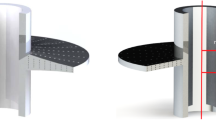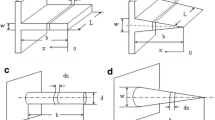Abstract
The performance characteristics and temperature field of conducting–convecting–radiating annular fin are investigated. The nonlinear variation of thermal conductivity, power law dependency of heat transfer coefficient, linear variation of surface emissivity, and heat generation with the temperature are considered in the analysis. A semi-analytical approach, homotopy perturbation method is employed to solve the nonlinear differential equation of heat transfer. The analysis is presented in non-dimensional form, and the effect of various non-dimensional thermal parameters such as conduction–convection parameter, conduction–radiation parameter, linear and nonlinear variable thermal conductivity parameter, emissivity parameter, heat generation number and variable heat generation parameter are studied. For the correctness of the present analytical solution, the results are compared with the results available in the literature. In addition to forward problem, an inverse approach namely differential evolution method is employed for estimating the unknown thermal parameters for a given temperature field. The temperature fields are reconstructed using the inverse parameters and found to be in good agreement with the forward solution.












Similar content being viewed by others
Abbreviations
- r i , r o , t :
-
Inner radius, outer radius and thickness of the fin
- h(T):
-
Coefficient of convective heat transfer
- k(T):
-
Thermal conductivity
- k o , h b , q o , ε s :
-
Parameters describing the coefficients of thermal conductivity, convective heat transfer, internal heat generation and surface emissivity at ambient temperature
- κ, γ :
-
Parameters describing the linear and non-linear variation of thermal conductivity
- λ, e :
-
Parameters describing the variation of surface emissivity and internal heat generation
- β, β 1 :
-
Non-dimensional parameters describing the variation of linear and non-linear thermal conductivity parameter
- n :
-
Exponent of variable convective heat transfer coefficient
- N :
-
Non-dimensional thermo-geometric parameter, \(\left( {2hr_{i}^{2} /k_{o} t} \right)^{0.5}\)
- M :
-
Non-dimensional conduction-radiation parameter, \((2r_{i}^{2} \sigma \varepsilon_{s} T_{b}^{3} /k_{o} t)\)
- G :
-
Non-dimensional heat generation parameter, \(G = q_{o} r_{i}^{2} /k_{o} T_{b}\)
- E G :
-
Non-dimensional parameter describing the variation of heat generation
- T b :
-
Base temperature of fin
- T a :
-
Ambient temperature
- c 1, c 2, C 1, C 2 :
-
Constants of integration
- \(\xi\) :
-
Dimensionless radius of fin, \(\xi = \, \left( {r - r_{i} } \right)/r_{i}\)
- R :
-
Dimensionless outer radius ratio, R = r o /r i
- θ :
-
Dimensionless temperature, θ = (T − T a)/(T b − T a)
- p :
-
Imbedding parameter
- η :
-
Fin efficiency
- Q f :
-
Actual heat transfer
- Q max :
-
Maximum possible heat transfer
- F(ξ):
-
Objective function
References
Kraus AD, Aziz A, Welty JR (2002) Extended surface heat transfer. Wiley, New York
Sunden B, Heggs PJ (2000) Recent advances in analysis of heat transfer for fin type surfaces. WIT Press, Boston
Mokheimer EMA (2002) Performance of annular fins with different profiles subject to variable heat transfer coefficient. Int J Heat Mass Transf 45:3631–3642
Zubair SM, Al-Garni AZ, Nizami JS (1996) The optimal dimensions of circular fins with variable profile and temperature dependent thermal conductivity. Int J Heat Mass Transf 39(16):3431–3439
Yu LT, Chen CK (1999) Optimization of circular fins with variable thermal parameters. J Frankl Inst 336B:77–95
Laor K, Kalman H (1996) Performance and optimum dimensions of different cooling fins with a temperature dependent heat transfer coefficient. Int J Heat Mass Transf 39(9):1993–2003
Arslanturk C (2009) Correlation equations for optimum design of annular fins with temperature dependent thermal conductivity. Heat Mass Transf 45:519–525
Khan JM, Zubair SM (1999) The optimal dimensions of convective–radiating circular fins. Heat Mass Transf 35:469–478
Chiu CH, Chen CK (2002) Application of the decomposition method to thermal stresses in isotropic circular fins with temperature dependent thermal conductivity. Acta Mech 157:147–158
Malekzadeh P, Rahideh H, Karami G (2006) Optimization of convective–radiative fins by using differential quadrature element method. Energy Convers Manag 47:1505–1514
Peng HS, Chen CL (2011) Hybrid differential transformation and finite difference method to annular fin with temperature-dependent thermal conductivity. Int J Heat Mass Transf 54:2427–2433
Aksoy IG (2013) Thermal analysis of annular fins with temperature-dependent thermal properties. Appl Math Mech Engl Ed. 34(11):1349–1360
Aziz A, Bouaziz MN (2011) A least squares method for a longitudinal fin with temperature dependent internal heat generation and thermal conductivity. Energy Convers Manag 52:2876–2882
Georgiou E, Razelos P (1993) Performance analysis and optimization of convective annular fins with internal heat generation. Wfirme- und Stofffibertragung 28:275–284
Hosseini K, Daneshian B, Amanifard N, Ansari R (2012) Homotopy analysis method for a fin with temperature dependent internal heat generation and thermal conductivity. Int J Nonlinear Sci 14(2):201–210
Hatami M, Hasanpour A, Ganji DD (2013) Heat transfer study through porous fins (Si3N4 and Al) with temperature-dependent heat generation. Energy Convers Manag 74:9–16
Torabi M, Zhang QB (2013) Analytical solution for evaluating the thermal performance and efficiency of convective–radiative straight fins with various profiles and considering all non-linearities. Energy Convers Manag 66:199–210
Singh K, Das R Generalized inverse analysis for fins of different profiles with all temperature dependent parameters. Heat Mass Transf doi:10.1007/s00231-015-1676-2
Sun Y, Ma J, Li B, Guo Z (2016) Predication of nonlinear heat transfer in a convective–radiative fin with temperature-dependent properties by the collocation spectral method. Numer Heat Transf Part B Fundam 69:68–83
Das R (2011) A simplex search method for convective–conductive fin with variable conductivity. Int J Heat Mass Transf 54:5001–5009
Mallick A, Das R (2014) Application of simplex search method for predicting unknown parameters in an annular fin subjected to thermal stresses. J Thermal Stresses 37:236–251
He JH (1998) An approximate solution technique depending on an artificial parameter: a special example. Commun Nonlinear Sci Numer Simul 3(2):92–97
He JH (1999) Homotopy perturbation technique. Comput Methods Appl Mech Eng 178(3–4):257–262
Storn R, Prince K (1997) Differential evolution—a simple and efficient heuristic for global optimization over continuous spaces. J Glob Optim 11:341–359
Young T, Mohlenkamp M (2009) Introduction to numerical methods and matlab programming for engineers. Ohio University Department of Mathematics OH
Author information
Authors and Affiliations
Corresponding author
Additional information
An erratum to this article is available at http://dx.doi.org/10.1007/s00231-016-1913-3.
Rights and permissions
About this article
Cite this article
Ranjan, R., Mallick, A. & Prasad, D.K. Closed form solution for a conductive–convective–radiative annular fin with multiple nonlinearities and its inverse analysis. Heat Mass Transfer 53, 1037–1049 (2017). https://doi.org/10.1007/s00231-016-1872-8
Received:
Accepted:
Published:
Issue Date:
DOI: https://doi.org/10.1007/s00231-016-1872-8




